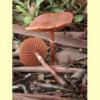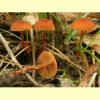.jpg)
images/Tubaria/Tubaria_rufofulva_KRT2783(1).jpg
Small to medium agaric, growing on the ground, in litter or mulch or on wood, with a rusty to ochre-brown spore print. Pileus brown or red or pink, rarely with purple tints, not viscid, hygrophanous. Lamellae adnate or subdecurrent. Stipe central. Partial veil remnants a ring zone or a membranous annulus. Spores pale or yellow-brown, smooth (rarely warty in extra-Australian species); plage and germ pore absent. Cheilocystidia present. Lamellar trama regular. Pileipellis a cutis, rarely a trichoderm. Clamp connections present.
Fruit-bodies of
Tubaria can resemble those of
Laccaria in colour and stature, and are also strongly hygrophanous; but lamellae in the latter are somewhat thickened and not close, there are no veil remnants, the spore print is white and the spores are spinose. Smaller species of
Cortinarius can be distinguished by their warty spores (rare in
Tubaria) and they generally lack cheilocystidia. In addition,
Cortinarius has a broader colour range than
Tubaria, which is usually yellow- or reddish brown, and rarely has purple tints (only sometimes in
Tubaria rufofulva).
Pholiotina is distinguished by the hymeniderm pileipellis and
Simocybe by the pileipellis which is an epithelium or trichoderm. In
Galerina the spores are usually warty with a plage. Smooth-spored species of
Galerina usually have a germ pore, and otherwise lack a partial veil.
Pholiota has a viscid pileus when fresh, and chrysocystidia are often present.
Tubaria (W.G.Sm.) Gillet, Hyménomycètes 537 (1876).
Several species: Tubaria fiveashiana, T. furfuracea, T. rufofulva and T. serrulata. Several other undescribed species.
W.A., S.A., N.S.W., Vic. and Tas. (and probably also N.T. and Qld).
In native forests, often along tracksides, and in parks and gardens.
On the ground, litter, mulch or wood.
Saprotrophic.
Bougher, N.L. (2009a),
Fungi of the Perth region and beyond: a self-managed field book, Western Australian Naturalists' Club (Inc.), Perth. [
Description and
Illustration of
T. serrulata]
Bougher, N.L. & Syme, K. (1998), Fungi of Southern Australia. University of Western Australia Press, Nedlands. [Description, Illustration and Microcharacters of T. rufofulva]
Breitenbach, J. & Kränzlin, F. (eds) (1995), Fungi of Switzerland. Volume 4. Agarics 2nd part. Edition Mykologia, Lucerne. [Description, Microcharacters and Illustration of four Swiss species, including T. furfuracea]
Fuhrer, B. (2005), A Field Guide to Australian Fungi. Bloomings Books, Hawthorn. [Description and Illustration of T. rufofulva]
Grey, P. & Grey, E. (2005), Fungi Down Under. Fungimap, South Yarra. [Description, Illustration and Map for T. rufofulva, and Illustration of T. fiveashiana]
Grgurinovic, C.A. (1997a), Larger Fungi of South Australia. The Botanic Gardens of Adelaide and State Herbarium and The Flora and Fauna of South Australia Handbooks Committee, Adelaide. [Description and Microcharacters of T. fiveashiana, T. furfuracea and T. rufofulva]
Matheny, P.B., Vellinga, E.C., Bougher, N.L., Ceska, O., Moreau, P.-A., Neves, M.A. & Ammirati, J.F. (2007b), Taxonomy of displaced species in Tubaria, Mycologia 99: 569–585.[Key, Description, Illustration and Microcharacters for T. rufofulva and T. serrulata]
McCann, I.R. (2003), Australian Fungi Illustrated. Macdown Productions, Vermont. [Illustration of T. rufofulva and several unidentified species]
.jpg)
_sml.jpg)




_AK_25_sml.jpg)
